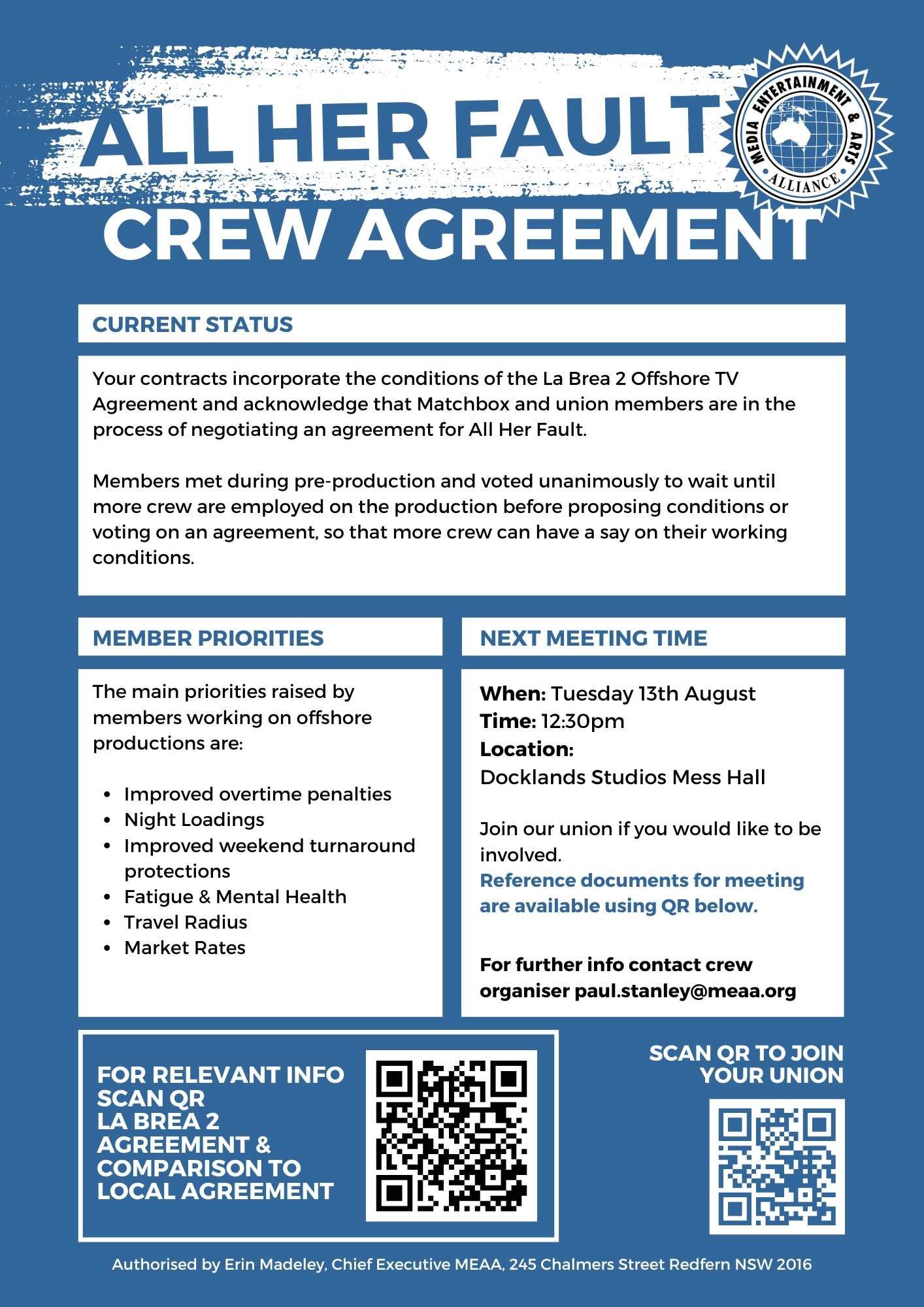Media, Entertainment and Arts Alliance is a union of workers across the arts, entertainment and media industries. MEAA is your union.MEAA screen crew work on television and film productions across Australia. From key creatives through to runners; our members are on set,
off set, in pre production and post, working together to bring stories to screen for millions of people around the world.As a collective, we strive for a strong industry that provides well paid, safe, professional jobs for crew - and for their families. Our actions are never for the advancement of the individual alone. That’s why we act to make changes that benefit everyone.MEAA members are building fairer and safer workplaces for today – and tomorrow.
What is MEAA?
The Media, Entertainment and Arts Alliance is a union of workers that make up our cultural workforce across the arts, entertainment and media industries.MEAA screen crew members have a strong and growing presence in scripted production and are allied with our fellow crew worker unions internationally through UNI-MEI.
How are decisions on agreements made?
MEAA is a democratic union. The MEAA screen negotiating committee is made up of elected and endorsed members from across the industry who take part in negotiations and help steer campaigns.Decisions on agreements are made collectively by members. To be a part of the decision-making process and the campaign for a more sustainable industry for crew, join MEAA.
More information?
If you have other questions about MEAA, contact MEAA Member Services Team on 1300 656 513 or members@meaa.org.
Get Involved
“We need to build our industry in a way that sustains crew instead of breaking them. Membership is growing, but we need everyone to get on board to make an ongoing difference. We need all crew to stand together as union members.”
– MEAA Screen Negotiating Committee
Are you a crew member committed to working with your coworkers to protect and improve working conditions in the screen industry?
Get in contact about joining MEAA by filling in the form below:
Already a member?You can support the campaign by organising your colleagues.
You can print off a petition, collect signatures and send it to your local organiser or members@meaa.org.
You can also talk to them about joining MEAA (printable membership forms here).
If you want to help with organising your colleagues, talk to your local screen crew organiser, or contact MEAA Member Services Team for more information on 1300 656 513 or members@meaa.org
Resources
Take Action
Reports and Updates
Agreements and safety code
Agreement Summaries
Travel radius tool
for google maps
Click the links below to view a handy radius tool in Google Maps that you can save and use to measure travel time and km's from the GPO radius to your place of call.The Motion Picture Production Agreement (MPPA) sets a 20km travel radius from a capital city's GPO. The Offshore Film Agreement sets a 30km travel radius from the GPO or studio. Any travel beyond the radius is counted as time worked. If using your own vehicle, all km’s travelled attract an allowance.
| State | Travel Radius Map |
|---|---|
| NSW | Sydney GPO |
| QLD | Brisbane |
| SA | Adelaide GPO |
| TAS | Hobart GPO |
| VIC | Melbourne GPO |
| WA | Perth GPO |
Membership Benefits
MPPA Negotiations
The MEAA screen negotiating committee has been bargaining with Screen Producers Australia (SPA) for more than a year to update the MPPA.Now we are calling on all screen crew to come to town hall meetings to discuss proposals to change baseline conditions on radius, turnaround, working days and the way forward on rates.Download the summary document below to read the latest info on the outstanding issues and register for one of the online town hall meetings.
FREQUENTLY ASKED QUESTIONS
This means that we DO expect the rates and conditions in our Code to be enforced in the traditional styles of dance - such as classical, Latin, and contemporary - but also in more non-traditional areas - such as street styles, aerial and silk performers, cabaret, burlesque, and many more.
However, it is important to note that some of the larger dance companies - like the Sydney Dance Company or the Australian Ballet - have their own agreements, that provide for higher rates, and better conditions. If in doubt, contact us.
It is conceivable that, where a gig is especially physically demanding, the above best practice could become a requirement under WHS law, and the Union would have a duty to enforce that.
For example, a male-identifying dancer may be expected to bring their staple items of a white shirt, black shirt, black dress pants and black jazz shoes with the rest of the costume provided by the Employer. The dancer would not be compensated for these items.
Some indicators for intermediate choreography would be:
- in a venue housing up to 100 sitting audience members;
- where corporate or government money do not make up the majority of funding;
- the performers may include professionals and non-professionals (ie. does not necessarily need to be a professional dancer in order to learn the choreography);
- where non-professionals are engaged, these will usually be pre-professional performers, such as students in a dance course; who have a good technical grounding in some dance skills;
- anything billed as pro-am would not go above this rate;
- basic roving work would usually not go above this rate unless specific skills were incorporated (any acrobatics, props, etc.);
- private events/functions (eg. weddings, parties, etc.) would usually not go above this rate unless they were very high budget, or included acts that had highly specialised skills.
Some indicators for advanced choreography would be:
- in a venue housing up to 250 sitting audience members;
- where corporate/government money makes up 50% of the funding;
- that are intended for public consumption, whether that be a fee-paying public audience, or a public audience at a larger event (such as a festival/fete);
- the performers will always be professionals under the definitions in the Code (ie. they will need to have demonstrable professional skills in dance to undertake the choreography).
At times, it is also helpful to define these categories ‘by exclusion’; ie.
- “a production at a small performance space is not top-tier as there are less than 250 seats, so would therefore be advanced”;
- “a wedding performance is not a production for a fee-paying public audience, therefore it is intermediate”;
- “a roving or crowd piece is not for a fee paying audience, therefore it is intermediate”.
If the performer travels directly from their place of residence to the venue, the entire time would be paid as time worked; if the performer travelled to the Employer’s place of business and then was taken to the venue, then the time from the Employer’s place of business to the venue would be paid.
We would generally expect this travel time to be paid at the rehearsal rate.
You would then be paid your appropriate hourly performance rate, for a minimum call of three hours.
We now know that the workplaces dancers experience are incredibly varied, especially for freelance dancers. We also know that dancers are very often having to choreograph their work, something that was not included in the Live Performance Award.
Our Code takes the wages and conditions from the Live Performance Award, and puts them in words that are understandable. We have included only the allowances and penalty rates that apply to dancers, and - by consulting with the industry - have created clear descriptions for each Dancer Level, based on experience and skill.
To ensure our Code is relevant to a variety of work, we have also used the 'Broadcasting' Award, which sets out the pay and conditions for performers on screen.
And finally, we have created a set of Choreography rates, based on the industry standard.
Companies, hirers, and schools that rely on the Fitness Industry Award are very likely underpaying their dance professionals, and not complying with the Fair Work Act.
If you are a member and your contract mentions the Fitness Industry Award we suggest that you contact us immediately.

